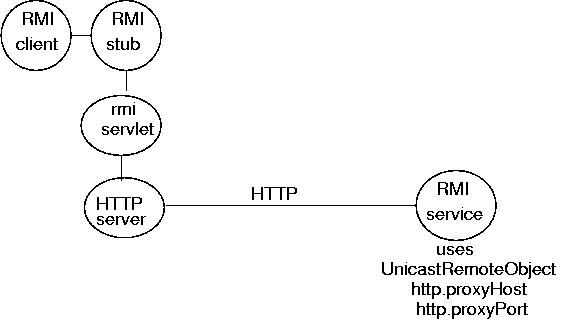Comparison of Client-Server Middleware
Middleware Systems
The underlying networking protocols on which middleware systems are built are
- IP
- UDP
- TCP
The middleware systems we have looked at are
- Sun ONC/RPC (Open Network Computing)
- RMI (Remote Method Invocation)
- CORBA (Common Object Request Broker Architecture)
- Web services (SOAP/WSDL/UDDI)
- Jini
- JXTA (to come)
There are a number of others that we haven't looked at, including
- Open Software Foundation DCE (Distributed Computing Environment)
- Microsoft DCOM
- Enterprise Java Beans
There are a lot of middleware services that we haven't looked at
- Transaction monitors
- Directory systems such as LDAP (Lightweight Directory Access Protocol)
- Messaging systems such as Java JMS
- Event-based systems such as Elvin
Data representation (what is moved)
| Sockets | byte/char streams |
| ONC | XDR (External data representation) |
| RMI | Java MarshalledObject |
| Web services | SOAP |
| CORBA | CDR (Common data representation) |
| Jini | Java MarshalledObject |
Transport (how it is moved)
| Sockets | TCP/UDP |
| ONC | XDR |
| RMI | JRMP (Java remote method protocol) |
| Web services | various, usually HTTP |
| CORBA | IIOP (Internet inter-orb protocol |
| Jini | Jini protocols (discovery, join, etc) |
Service description
| Sockets | none |
| ONC | Sun IDL (Interface definition language) |
| RMI | Java interface |
| Web services | WSDL (Web service description language) |
| CORBA | CORBA IDL |
| Jini | Java interface |
Locating services
| Sockets | known address |
| ONC | known address |
| RMI | RMI Naming Service |
| Web services | UDDI (Universal Description, Discovery and Integration) |
| CORBA | Naming service/Trader |
| Jini | Jini Lookup Service |
Lookup matching
| Sockets | none |
| ONC | none |
| RMI | exact string match |
| Web services | string searches |
| CORBA | string match or string search |
| Jini | object match |
Language bindings
| Sockets | Unix C, Java, Perl, Visual Basic, Visual C++, ... |
| ONC | Unix C, Java, Perl, ... |
| RMI | Java only (JDK 1.1 on, not Visual Java) |
| Web services | Java, .NET, Perl |
| CORBA | C, C++, Cobol, Python, ... |
| Jini | Java only (JDK 1.2 on) |
Language paradigm
| Sockets | streams |
| ONC | procedujre call |
| RMI | method call |
| Web services | procedure call |
| CORBA | method call |
| Jini | method call |
Remote reference
| Sockets | socket |
| ONC | opaque data structure |
| RMI | proxy object |
| Web services | URL |
| CORBA | proxy reference |
| Jini | proxy object |
Synchronicity
Some middleware systems support event mechanisms for asynchronous processing, some only support synchronous processing
| Sockets | synchronous |
| ONC | synchronous |
| RMI | synchronous |
| Web services | synchronous |
| CORBA | synchronous/asynchronous |
| Jini | synchronous/asynchronous |
Garbage collection
Some systems will garbage collect objects/services and clean up registries. Others won't.
| Sockets | no |
| ONC | no |
| RMI | yes |
| Web services | no |
| CORBA | no |
| Jini | yes |
Bridges
Can a Jini service talk to a CORBA client? Can a Web service be used by an ONC client? Generally not, even if the two middleware systems share lots of concepts (e.g. CORBA and RMI are both O/O based). Reasons
- the data type representations will be different
- the protocol format will be different
To allow services of one protocol to talk to clients of another, a bridge has to be built, where something understands enough of both protocols.
Jini to CORBA
See earlier lecture. Build a Jini service that is also a CORBA client to translate between protocols

RMI to CORBA
Standard RMI:

Since the client does not see the protocol, this can be changed
from JRMP to IIOP.
The server uses an object that uses IIOP instead of JRMP.
i.e. it uses PortableRemoteObject instead of
UnicastRemoteObject.

CORBA 2.3 introduced "objects by value". An ORB that supports this concept knows how to handle RMI stub objects

Tunnelling
Many RPC systems such as Sun ONC and RMI use a random port (above 1024) to perform the remote call. This means that it must be possible to connect to a random port. Network administrators do not like this, since attacks can be mounted on these ports.
Foe security, network admins will close off as many ports as they can, and only leave a few open. Typically they will leave open
- port 80 for HTTP traffic
- port 21 for an ftp server
- port 25 for mail
Tunnelling is the technique of wrapping a message as another protocol's message and sending it by the second protocol instead of the first. When the message arrives, it is unwrapped and sent to the correct receiver. HTTP tunnelling uses an HTTP server, and a CGI script (or equivalent). Messages are sent to the HTTP server which passes them to the CGI script. The CGI script knows how to handle the original message.

Jan Newmarch (http://jan.netcomp.monash.edu.au) [email protected]